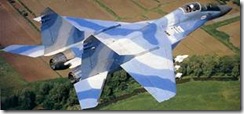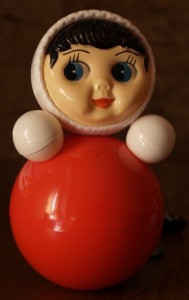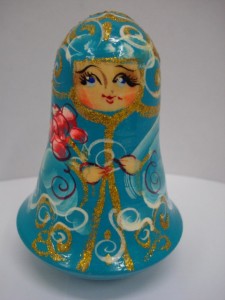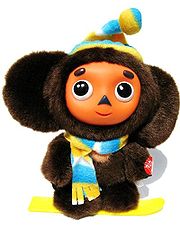The History of Russian Toys
Written by Vadim on March 3, 2009 – 12:00 am -
 Like cultures all over the globe, Russians have been collecting, playing with, and displaying toys for their entire history. Russian toys are unique, however, in that they have had influences from a wide variety of cultures and religions. Because they are the most abundant natural materials in Russia, wood and clay are the two most common ingredients of traditional Russian toys. Other than this, there are no hard and fast rules or themes.
Like cultures all over the globe, Russians have been collecting, playing with, and displaying toys for their entire history. Russian toys are unique, however, in that they have had influences from a wide variety of cultures and religions. Because they are the most abundant natural materials in Russia, wood and clay are the two most common ingredients of traditional Russian toys. Other than this, there are no hard and fast rules or themes.
Prehistoric Russian Toys: Few toys exist from prehistoric Russia, but they all follow a similar pattern to prehistoric toys found throughout the world. Simple musical instruments such as rattles and whistles have been found at archaeological sites as well as figurines of humans and animals that may have been rooted in religion and spirituality.
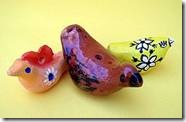 Slavic Era: Russia’s first existence as a nation and a culture was under the control of the Slavs, which are first recorded in the area before the first millennium AD. The early toys of this time were often in the shape of birds and other animals which had agricultural and/or seasonal significance. Penny whistles were popular as they were part of the worship of the Slavic god Yarilo. Simple wooden rattles and other early musical instruments were popular among adults and children alike.
Slavic Era: Russia’s first existence as a nation and a culture was under the control of the Slavs, which are first recorded in the area before the first millennium AD. The early toys of this time were often in the shape of birds and other animals which had agricultural and/or seasonal significance. Penny whistles were popular as they were part of the worship of the Slavic god Yarilo. Simple wooden rattles and other early musical instruments were popular among adults and children alike.
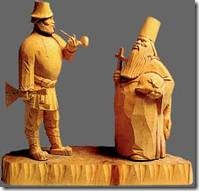 Byzantine Era: While the rest of the world was immersed in the Dark Ages, Russia was enjoying a rich and flourishing culture. Russians during this era had toys that could be made at home with simple materials and the skills that were common at that time. A popular toy from this era was a plain wooden statue or figurine depicting a figure or scene from popular folk tales. These were highly detailed and usually unpainted. Toys made in this ancient tradition are still being manufactured, most notably by craftsmen in Bogorodskoe.
Byzantine Era: While the rest of the world was immersed in the Dark Ages, Russia was enjoying a rich and flourishing culture. Russians during this era had toys that could be made at home with simple materials and the skills that were common at that time. A popular toy from this era was a plain wooden statue or figurine depicting a figure or scene from popular folk tales. These were highly detailed and usually unpainted. Toys made in this ancient tradition are still being manufactured, most notably by craftsmen in Bogorodskoe.
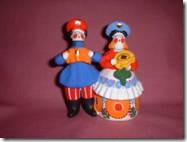 Czarist Era: Dymkovo, small painted clay toys named after the town where they were originally made, date back to the Czarist period of Russia and are also still made in modern times. They are notable because high quality dymkovo can be made at home by laymen. They typically are bright colored, simple, and feature characters and objects from nineteenth century Russian life.
Czarist Era: Dymkovo, small painted clay toys named after the town where they were originally made, date back to the Czarist period of Russia and are also still made in modern times. They are notable because high quality dymkovo can be made at home by laymen. They typically are bright colored, simple, and feature characters and objects from nineteenth century Russian life.
Nesting shapes became popular during this time, both as figurines and as toys. Ornately decorated eggs, apples, and other shapes were common. Toward the end of the nineteenth century, there was a resurgence of interest in traditional Russian crafts, which led to the creation of a ‘national toy’, the Matryoshka, which was ironically modeled after a Japanese nesting doll of similar design.
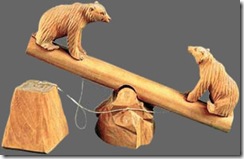 Communist Era: While many handicrafts were discouraged, others flourished. The simple wooden toys of eras past regained popularity and were now made to have moving parts. Bears were common, and were often shown eating at a table and performing other typically human activities.
Communist Era: While many handicrafts were discouraged, others flourished. The simple wooden toys of eras past regained popularity and were now made to have moving parts. Bears were common, and were often shown eating at a table and performing other typically human activities.
Modern Era: In an increasingly global economy, Russian children, like children everywhere, are playing with the commercialized toys marketed and sold by global companies. Toys based on Russian television programs are especially popular. However, the fall of the Soviet Union has resulted in a resurgence of folk craft and increased interest in traditional Russian arts and crafts. This, combined with a worldwide demand for Russian toys and memorabilia, is sure to result in a resurgence of distinctively Russian toys.
References:
http://en.wikipedia.org/wiki/Matryoshka_doll
http://en.wikipedia.org/wiki/East_Slav
http://en.wikipedia.org/wiki/Slav
http://en.wikipedia.org/wiki/Dymkovo_toys
http://www.kolinskyartbrushes.com/dymkovo-figurines/
http://www.artrusse.ca/bogorodskoe_en.htm
Tags: history, russian toys, toys, wooden toys
Posted in General | No Comments »
Matryoshka: An International Love Affair
Written by Vadim on February 27, 2009 – 12:00 am -Matryoshka: An International Love Affair
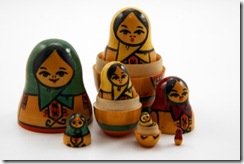 Perhaps the best known Russian toy, matryoshka, or wooden nesting dolls, are a relative newcomer to the world of Slavic toys. Although nesting toys in the shape of an egg or ball have been popular in Russia for centuries, nesting dolls first came to the country as a souvenir from Japan in the late nineteenth century. Since then, matryoshka have become one of the most beloved symbols of traditional Russian culture.
Perhaps the best known Russian toy, matryoshka, or wooden nesting dolls, are a relative newcomer to the world of Slavic toys. Although nesting toys in the shape of an egg or ball have been popular in Russia for centuries, nesting dolls first came to the country as a souvenir from Japan in the late nineteenth century. Since then, matryoshka have become one of the most beloved symbols of traditional Russian culture.
 Like the egg shaped toys preceding Matryoshka, nesting dolls are traditionally made with a lathe with the inner most doll created first. They are then painted, usually to resemble women and girls in traditional Eastern European dress. However, not all matryoshka are feminine. Nesting dolls have been made to resemble birds, characters from popular folk tales, and even Communist leaders of the twentieth century.
Like the egg shaped toys preceding Matryoshka, nesting dolls are traditionally made with a lathe with the inner most doll created first. They are then painted, usually to resemble women and girls in traditional Eastern European dress. However, not all matryoshka are feminine. Nesting dolls have been made to resemble birds, characters from popular folk tales, and even Communist leaders of the twentieth century.
The most remarkable feature of matryoshka is usually the elaborate painting. Regardless of the theme or type of characters, Russian nesting dolls are painted in vibrant colors, then heavily varnished. The designs are usually reminiscent of traditional agrarian Russian culture.
The name ‘Matryoshka’ has its own colorful history. At the time that nesting dolls became popular in Russia, Matryona was a widespread female name, with Matryoshka the most common nickname. In addition, the name Matryona comes from ‘mater’, the Latin word for mother. Because the dolls had a maternal theme, with several females nested inside each other, this name took hold in Russia and is now internationally recognized.
During the Soviet era, traditional matryoshka dolls became rare enough to be almost an endangered species. The government did not allow the sale or display of handicrafts. Although there were matryoshka factories, the dolls made there had to be manufactured in an efficient, assembly line manner that took the warmth and uniqueness from this traditionally handmade toy and made more traditional, complicated designs impossible. Although some toys were illegally made and exported throughout this time, handmade and hand-painted nesting dolls from Russia were not commonly available until after the fall of the Soviet Union.
Matryoshka dolls have a variety of uses in the modern world. They remain beloved toys for children and the young at heart all around the world. Nesting dolls can also make a quaint yet cultured addition to home decoration. They have been used as promotional items from companies and even as invitations to weddings. Matryoshka bring a distinctively Eastern European flavor wherever they appear.
Matryoshka dolls have become not just a recognizable symbol of old Russia, but a metaphor as well. The word ‘matryoshka’ is often used to describe like items neatly nesting inside each other, such as makeup kits or storage containers. They have made their mark in every field from astroengineering (“The Matryoshka Brain”) to children’s television (“Higglytown Heroes”). This may be due to the enduring nature of a nesting doll. Like these distinctive nesting dolls, we all have multiple layers just waiting to be discovered. Perhaps this is the true reason matryoshka nesting dolls have captured hearts all over the world. 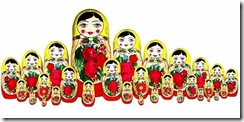
References:
http://en.wikipedia.org/wiki/Matryoshka
http://www.madehow.com/Volume-6/Matryoshka-Doll.html
http://www.angelfire.com/art2/petrikovka/matryoshkahistory.html
Tags: matryoshka doll, toys
Posted in General | No Comments »
War and Peace: Russian Military Memorabilia
Written by Vadim on February 17, 2009 – 12:00 am -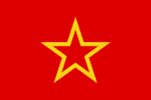 Why do military toys have such a prominent position in every Russian memorabilia collection? Simply, it is because the military was a huge part of Russian life during the twentieth century. The Soviet military was not just a defense department, but a symbol of the strength and power of communism. Military strength was held up as a communist ideal, which can be seen in the government’s names for the military: “The Red Army” and “Army of Workers and Peasants.” Red was a popular color throughout the Communist regime because it symbolized the blood that was shed in the struggle against capitalism.
Why do military toys have such a prominent position in every Russian memorabilia collection? Simply, it is because the military was a huge part of Russian life during the twentieth century. The Soviet military was not just a defense department, but a symbol of the strength and power of communism. Military strength was held up as a communist ideal, which can be seen in the government’s names for the military: “The Red Army” and “Army of Workers and Peasants.” Red was a popular color throughout the Communist regime because it symbolized the blood that was shed in the struggle against capitalism.
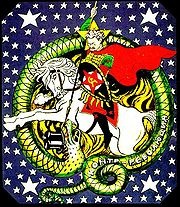 The Soviet military became a force outside its own borders when it captured Berlin in World War II, delivering a death blow to the Nazis. Suddenly, the symbols and weapons unique to the Soviet defense became objects of fascination throughout the rest of the world. Almost overnight, the Soviet Union emerged as a formidable and even frightening world power.
The Soviet military became a force outside its own borders when it captured Berlin in World War II, delivering a death blow to the Nazis. Suddenly, the symbols and weapons unique to the Soviet defense became objects of fascination throughout the rest of the world. Almost overnight, the Soviet Union emerged as a formidable and even frightening world power.
From the 1940’s through its collapse, the Soviet military was the largest in the world. By the 1970’s, it was the only country that boasted military strength rivaling that of the United States. This supremacy was due to two key factors: the Soviet Red Army soldiers and the superior weapons and military technology made available by the Soviet war machine.
The Soviet Army was able to maintain its size due to conscription. For many decades, every young man and many young women in the Soviet Union served at least two to three years in the military. In an empire so far-reaching, this was an impressive force. The soldiers were trained in military maneuvers and strategies as well as Soviet political philosophy.
The other strength of the Soviet military came from their weapons and military equipment. While many Americans are most familiar with the Soviet nuclear program, advances were made in almost every class of weapons. This came at a cost. During the 1980’s, 70% of the Soviet Union’s annual budget and 14% of the gross domestic product was spent on the military. However, this investment yielded some of the most impressive weapons in world history, including:
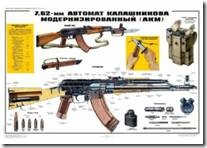 The AK-47/Kalashnikov rifle. Weapons experts estimate that more AK-47 rifles have been produced since its introduction in the late forties than all other assault rifles combined. This is a true assault weapon, with no use except taking human life. Durable, cheap, and easy to use, the AK-47 is all muscle and no mercy.
The AK-47/Kalashnikov rifle. Weapons experts estimate that more AK-47 rifles have been produced since its introduction in the late forties than all other assault rifles combined. This is a true assault weapon, with no use except taking human life. Durable, cheap, and easy to use, the AK-47 is all muscle and no mercy.
The MiG Fighter Jet. This is the best known of a huge collection of Soviet jets. Perhaps best known for its role in the American movie Top Gun, the MiG-29 is considered on par with top of the line American fighter jets such as the F-16.
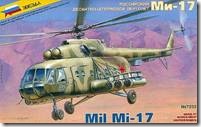 Soviet Military Helicopters. Although the Soviet military had a late start in helicopter manufacturing, they quickly became second only to the United States in helicopter technology. Russians currently design and supply military and civilian helicopters to nations around the globe.
Soviet Military Helicopters. Although the Soviet military had a late start in helicopter manufacturing, they quickly became second only to the United States in helicopter technology. Russians currently design and supply military and civilian helicopters to nations around the globe.
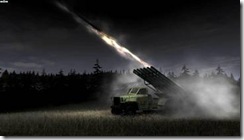 Soviet Missiles. Unlike the United States military, the Soviet Union maintained a branch of the military devoted entirely to missiles and rocketry, the Strategic Rocket Forces. This has yielded some of the most advanced rockets in the world, including the famous Katyusha Rocket of WWII and the SS-9 “Satan” that gained infamy during the Cold War for its potential as a weapon of first strike.
Soviet Missiles. Unlike the United States military, the Soviet Union maintained a branch of the military devoted entirely to missiles and rocketry, the Strategic Rocket Forces. This has yielded some of the most advanced rockets in the world, including the famous Katyusha Rocket of WWII and the SS-9 “Satan” that gained infamy during the Cold War for its potential as a weapon of first strike.
The fame and high quality of Soviet weapons, as well as their notable roles in battles that changed the course of world history, have made the Russian models and toys that resemble them a valued collector’s item for vintage toy collectors, war memorabilia collectors, and lovers of Russian culture. Unfortunately, the demand for these pieces of history is far greater than the supply of authentic Russian military toys.
References:
http://en.wikipedia.org/wiki/Soviet_Armed_Forces
http://en.wikipedia.org/wiki/Red_army
http://www.britannica.com/EBchecked/topic/494046/Red-Army
http://en.wikipedia.org/wiki/AK-47
http://en.wikipedia.org/wiki/MiG
http://www.centennialofflight.gov/essay/Rotary/Soviet/HE19.htm
http://en.wikipedia.org/wiki/Katyusha
Tags: MiG, military toys, missile, rocket, tanks, toys
Posted in General | No Comments »
Russian Tumbler Toys Nevalyashka and Vanka Vstanka
Written by Vadim on November 22, 2008 – 12:00 pm -In Russia and many former Soviet countries, almost every child played with one of these toys when they were little – an upright doll with a round heavy base that stands on the floor. When you try and push the doll over, it springs back upright.
In Russian, they go by two names – ‘Nevalyashka’, meaning ‘One who never lies down’ and ‘Vanka Vstanka’ – a rhyming, alliterative phrase meaning ‘Ivan get up’. Vanka Vstanka is also the name of a contemporary Russian energy drink, similar to Red Bull.
In English, they are referred to as ‘Tilting Dolls’, ‘Bell Dolls’, ‘Tumbler Toys’ and ‘Roly Poly Toys’.
Nevalyashkas come in two popular varieties – one with an internal bell that rings when the doll shakes [as shown above] and other variety which is made of timber that can be painted [shown below].
It has been suggested by Elena Marus of the site WOW Russia, that the Nevalyashka/Vanka Vstanka is a dual-purpose toy that is intended to develop an infant’s hearing and sense of touch. She also states that it is purported to “develop creativity, imagination, hearing and movement co-ordination in children, but nobody knows exactly how it works”.
Here is a video showing the Nevalyashka doll in action:
Tags: dolls, nevalyashka, toys, tumbler, vanka vstanka
Posted in General | No Comments »
The Story of Cheburashka
Written by Vadim on November 17, 2008 – 8:50 pm -Cheburashka is a famous character in Russian children’s literature. He was first introduced in 1965, in a story named “Gena the Crocodile and His Friends”, created by the Russian writer Eduard Uspensky.
According to the story, Cheburashka is a funny little animal, unknown to science, with an appearance that can be characterized as being somewhere between that of a monkey and a bear. He lives in the tropical forest. Cheburashka’s name means “one, who tumbles down”. He is described as “feeling lonely” and “searching for identity”.
Cheburashka has appeared in several books and animated series:
- 1969 – Gena the Crocodile and His Friends
- 1971 – Cheburashka
- 1974 – Old Lady Shapoklyak
- 1983 – Cheburashka Goes to School
He was used as the mascot of the Russian Olympic team in the 2004 Summer Olympics in Greece and a white-coloured Cheburashka was used in the 2006 Winter Olympic Games in Turin, Italy.
Cheburashka may have inspired the development of the Japanese ‘Pokemon’ [Pocket Monsters] phenomenon decades later in the 1990s. Indeed, Cheburashka has developed a loyal following in Japan following the screening of an animated film series between 2001 and 2002.
Collectibles are widely sold in Russia, former Soviet Republics and Japan.
Here is video from the Soviet animated TV series, subtitled in English:
Tags: cheburashka, dolls, toys
Posted in General | No Comments »
